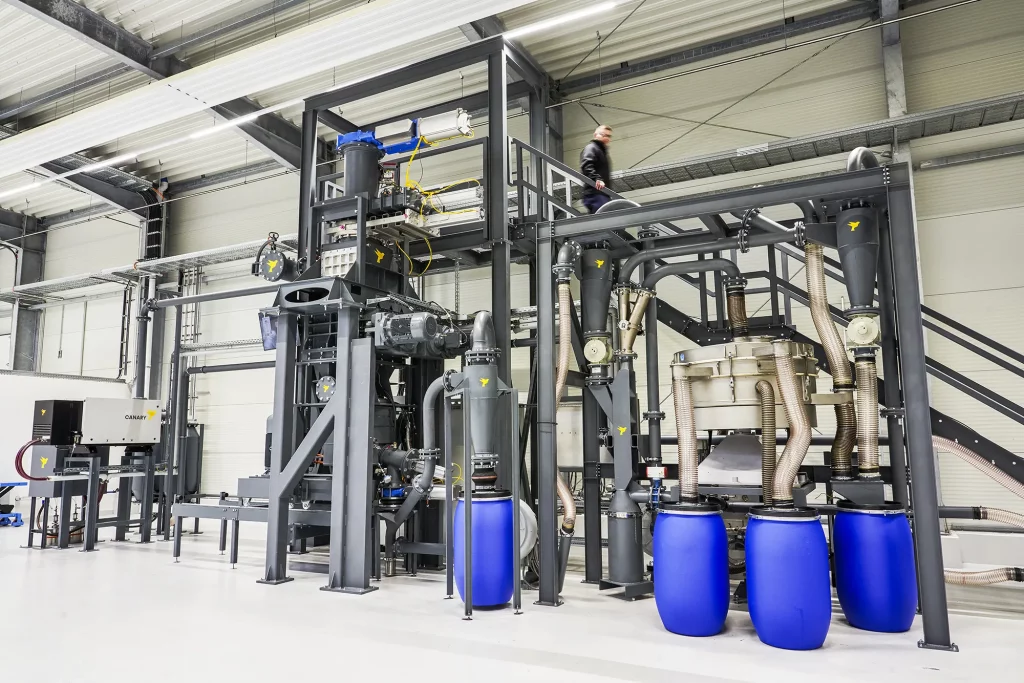Air jet sieving
In the air jet sieving process step, No Canary separates the fine, valuable powders ( ly known as black mass) from the remaining particles. Imagine a giant “tea strainer” through which a stream of air is blown: The fine powder from the crushed lithium-ion battery is pulled through the sieve by the air stream, while larger particles such as foil scraps or residual pieces remain on the sieve. We obtain a high-purity raw material powder (black mass) by separating it from impurities using air technology. This step ensures that the valuable ingredients – lithium, nickel, cobalt, graphite, etc. – are ultimately available as a concentrated product, free of interfering foil or plastic parts. Our air jet sieving technology thus significantly increases the quality and market value of the recycled raw materials and demonstrates how effective and modern our recycling plants are.

We supply a complete air sieving unit that is integrated into the product module of our plant. At its heart is an air jet sieve – a special sieve housing in which a defined fine sieve (e.g., 500 µm mesh size) is installed horizontally. A controlled air flow is generated from below using a high-pressure blower, which sucks or blows the fine particles through the screen. The coarser particles (e.g., film scraps ~1–5 mm) cannot pass through the screen openings due to their size; they remain on top and are discharged at the edge. The fine dust – the black mass, usually <100 µm particle size – is carried by the air flow into the downstream cyclones and filters, where it is separated and collected. We therefore offer recyclers/OEMs a closed system: a fine screen with a defined separation efficiency (often around ~500 µm) plus an air conveyor system and dust separation. This system runs continuously: the material is pneumatically fed onto the screen and the air flow circulates in a cycle (the air is returned after filtering to avoid emissions). Our offer includes all the hardware – screening machine, blower, cyclone, filter, piping, valves – fully assembled. For the operator, this means that they receive high-purity black mass in the collection container and, separately, a residue of foil flakes, which is further processed (in our case, this residue goes to another zig-zag screening process to separate plastic from metal foils). Air jet screening is a key component in separating the fine recyclables from the rest of the material stream – we offer it as a robust, low-maintenance module in our recycling line.
Some important key figures are:
100-1000 µm
Screen fineness (mesh size)
> 99 %
of the active mass passes through the sieve (fine fraction) – Black Mass Recovery
< 1,5 %
(weight %) metal/plastic foil – Residual foil in black mass
50 – 2,000 kg/h
Throughput
Freely adjustable
Air flow rate
0.5 – 5 mm
Coarse material (foils, etc.), is retained
closed air circuit, negative pressure operation
Operating mode
~ 100 %
Separation efficiency (no dust escapes; total dust separation > 99,9 %)
* Referenzmessung mit Panasonic NCA 21700 (TESLA Model 3) nach Trocknung bei 40°C für 30 Minuten mit der No Canary-Technologie. Gerne können Sie Ihre eigenen Batterien an unserem Standort testen!
Automatic, interval-controlled
Filter cleaning (compressed air pulses)
approx.
20 – 40 µm
Material Fine powder – D50 (graphite, metal oxides) – easily separable in cyclone/filter
Pressure monitoring, explosion-proof design optional, O₂ sensor if inerted